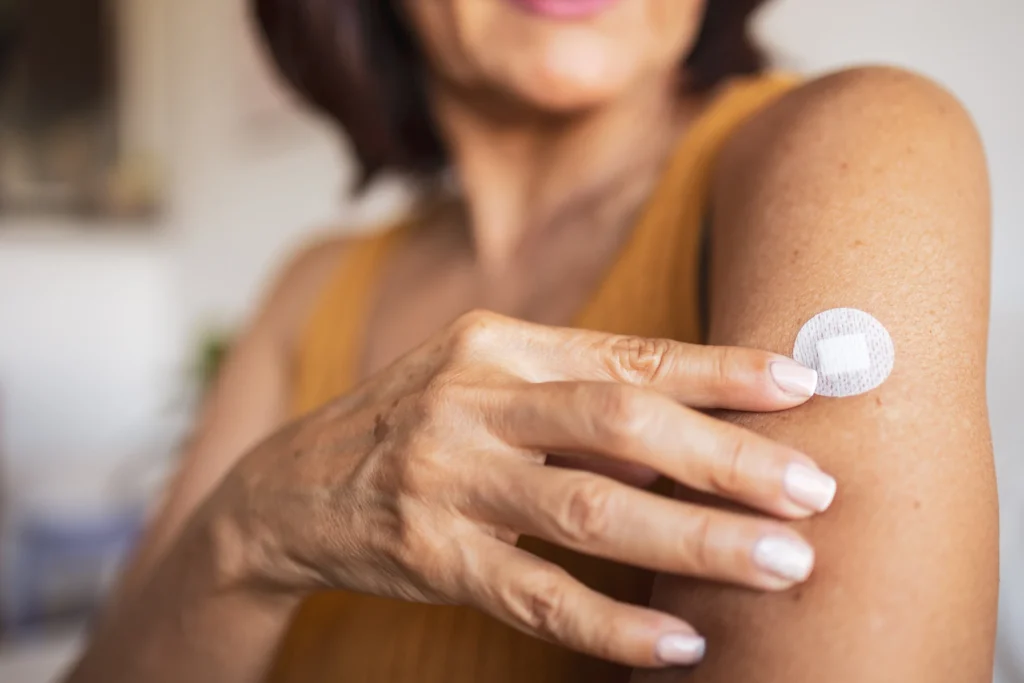For millions of women navigating perimenopause and menopause, symptoms like hot flashes, night sweats, mood swings, vaginal dryness, and sleep disturbances can drastically affect quality of life. Fortunately, today’s treatments offer more personalized and convenient solutions—one of the most effective and modern options being the transdermal estrogen patch.
This guide explores what transdermal estrogen patches are, how they work, who they benefit, and why they are considered a safe and effective choice for menopause symptom relief.
🌿 What Are Transdermal Estrogen Patches?
Transdermal estrogen patches are small, adhesive patches worn on the skin that deliver a steady dose of estrogen directly into the bloodstream through the skin (bypassing the digestive system).
Common Brand Names:
- Climara®
- Vivelle-Dot®
- Minivelle®
- Estraderm®
- Alora®
These patches are typically applied to the lower abdomen or buttocks and replaced once or twice a week, depending on the brand and dosage.
🧬 How Transdermal Estrogen Works
The patch delivers 17-beta estradiol, a bioidentical form of estrogen that is chemically identical to the hormone naturally produced by your ovaries. Unlike oral estrogen pills, patches allow the hormone to:
- Enter the bloodstream directly through the skin
- Avoid first-pass metabolism in the liver
- Maintain steady hormone levels throughout the day
This route reduces fluctuations and may lower certain risks associated with oral hormone therapy.
🌡️ Symptoms Treated by Estrogen Patches
Transdermal estrogen patches are highly effective at treating a range of menopausal symptoms, including:
| Symptom | Effect of Patch |
|---|---|
| Hot flashes | Reduces frequency and severity |
| Night sweats | Minimizes temperature spikes during sleep |
| Vaginal dryness | Improves lubrication and elasticity (systemically) |
| Mood swings & anxiety | Stabilizes mood by supporting neurotransmitters |
| Insomnia | Helps regulate sleep patterns |
| Bone loss | Prevents postmenopausal osteoporosis |
🩺 Benefits of Transdermal Estrogen Patches
✅ 1. Bypasses the Liver
Unlike oral estrogen, patches skip the liver’s first-pass metabolism. This means:
- Lower impact on blood clotting factors
- Reduced risk of stroke and deep vein thrombosis (DVT)
✅ 2. Stable Hormone Levels
Patches provide a continuous, low-dose release of estrogen, avoiding the hormonal highs and lows seen with pills or injections.
✅ 3. Lower Risk for Certain Conditions
- Safer for women with high triglycerides
- Better for those with gallbladder disease
- Fewer effects on liver enzymes
✅ 4. Convenient Dosing
- Once- or twice-weekly application
- Discreet, comfortable, and low maintenance
✅ 5. Improved Cardiovascular Profile
Studies suggest that transdermal estrogen may have less impact on inflammation and blood clotting, making it a preferred option for women with heart risk factors.
⚠️ Considerations and Possible Side Effects
While generally well tolerated, some women may experience:
- Skin irritation at the application site
- Breast tenderness
- Headaches
- Mild bloating or nausea
Important: If you still have your uterus, you must combine estrogen therapy with a progestogen to prevent the risk of endometrial cancer.
👩⚕️ Who Is a Good Candidate for Transdermal Estrogen?
This form of hormone therapy is especially beneficial for:
- Women in early menopause (within 10 years of last period)
- Women with moderate to severe hot flashes
- Those with risk factors for blood clots or stroke
- Women with migraine headaches (which can worsen with oral estrogen)
- Women who prefer non-pill options or have GI sensitivity
❌ Who Should Avoid Estrogen Therapy?
Hormone therapy may not be appropriate for women with:
- History of breast or endometrial cancer
- Unexplained vaginal bleeding
- Active liver disease
- History of stroke or blood clots (in some cases)
Always consult your healthcare provider for a personalized risk assessment.
📋 How to Use a Transdermal Estrogen Patch
Step-by-Step Guide:
- Choose a clean, dry area on the lower abdomen or buttock.
- Avoid areas with cuts, irritation, or lotion.
- Apply patch firmly for at least 10 seconds.
- Change patch on the same days each week.
- Rotate application sites to avoid skin irritation.
🧠 Frequently Asked Questions
Q: How long does it take for the patch to start working?
A: Many women notice relief from hot flashes and sleep issues within 1–2 weeks.
Q: Can I shower or swim while wearing the patch?
A: Yes, the patch is designed to stay on during normal activities, including swimming and bathing.
Q: Do I need progesterone with the patch?
A: If you have a uterus, yes—to prevent endometrial overgrowth and cancer risk.
Q: How long can I use hormone patches?
A: Most guidelines suggest using HT for up to 5 years, but duration should be personalized based on symptoms and health risks.
💡 Final Thoughts
Transdermal estrogen patches offer a modern, safe, and effective solution for managing menopause symptoms. With steady hormone delivery, minimal impact on the liver, and fewer cardiovascular risks, patches are often the first choice for women who want relief without the rollercoaster of pills.
If you’re entering menopause or struggling with ongoing symptoms, talk to a menopause-trained healthcare provider about whether a patch could be the right fit for you.




